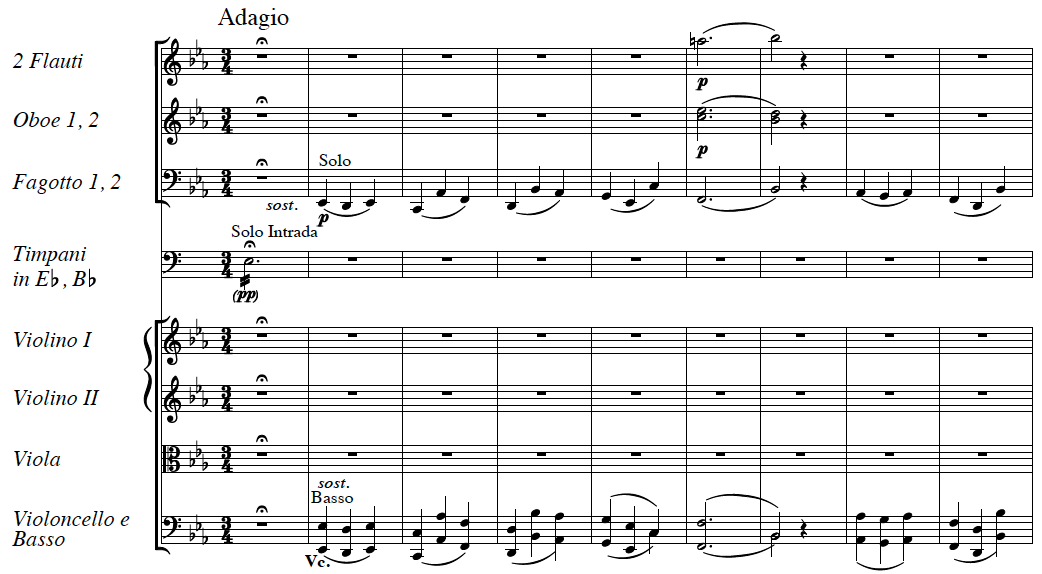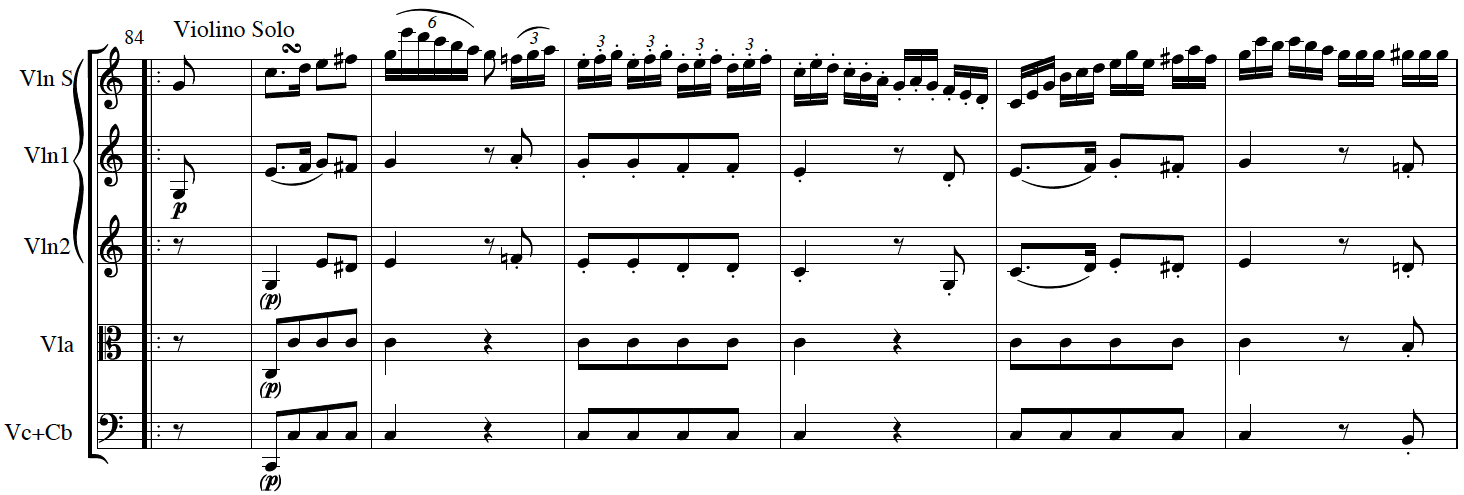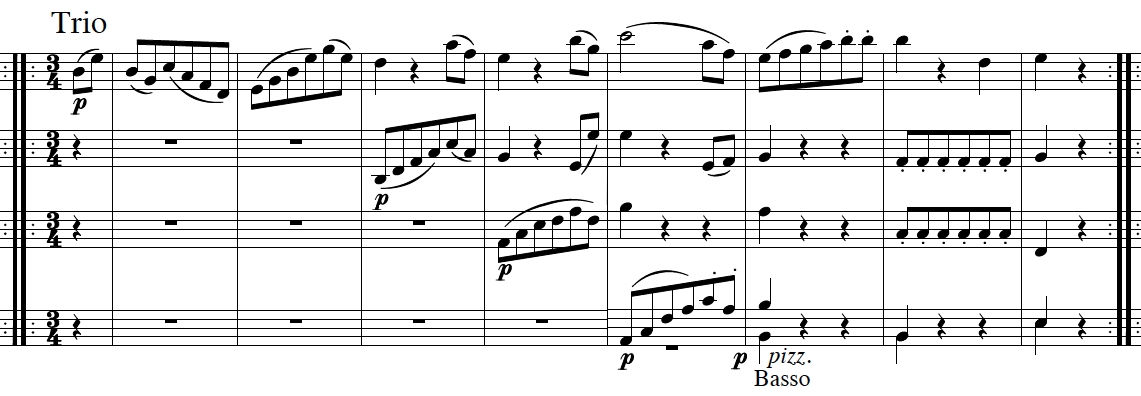Franz Joseph Haydn
Symphony No.103 in E♭ major, “Drumroll”
Media Review / Comparison
2014-12-11 — Original posting
2014-12-17 — Added links to concert review
2015-08-09 — Amendment about Thomas Fey
2016-02-15 — Amendment about new, planned integral recording
2016-07-30 — Brushed up for better readability
2022-11-29 — Minor update (see below)
Table of Contents
Introduction / The Recordings in This Review
This posting is about the Symphony No.103 in E♭ major, “Drumroll”, by Franz Joseph Haydn (1732 – 1809), of which I currently have two recordings:
- Antal Doráti, Philharmonia Hungarica (1972)
- Dennis Russell Davies, Stuttgarter Kammerorchester (2009)
Integral Recordings of Haydn’s Symphonies
Antal Doráti / Philharmonia Hungarica
I already had Antal Doráti‘s complete Haydn Symphonies on LP. This (i.e., nostalgia) is the main reason why I recently purchased the same recording on CD, knowing that it doesn’t satisfy my interest in historically more informed playing.
Dennis Russel Davies / Stuttgarter Kammerorchester
To address that (to a limited degree), I added Dennis Russel Davies‘ recording.
Ádám Fischer / Austro-Hungarian Haydn Orchestra
An alternative might have been the other recent, complete recording by Ádám Fischer (*1949) with the Austro-Hungarian Haydn Orchestra. They recorded the symphonies in chronological order. I decided for Davies’ recording after reading interviews in which Fischer stated that after completing the recording he would have preferred to return to the early symphonies and redo them, based on the insights that he gained with the later symphonies over the several years of the recording. Maybe my hesitations were not justified. But given the sheer volume of Haydn’s symphony oeuvre I’m not easily be re-visiting this any time soon.
Thomas Fey / Heidelberg Symphony Orchestra
Meanwhile, there is yet another complete recording in the making, by Thomas Fey (*1960) with the Heidelberg Symphony Orchestra, which I haven’t evaluated in detail either. Thomas Fey’s personal Web site has been cancelled, scarcely available Web resources mention a serious accident. [ Fey apparently won’t be able to conduct at least till 2016. I’m not sure what this means for the completion of this cycle. ]
Update 2022-11-29: In fall 2020, the orchestra elected the German conductor Johannes Klumpp (*1980) as Artistic Director of the orchestra. The orchestra’s German Wikipedia page states that under Johannes Klumpp, the orchestra has resumed working on the project of recording all Haydn symphonies.
Giovanni Antonini / Kammerorchester Basel
2016-02-15: The Kammerorchester Basel (Basel Chamber Orchestra) under the direction of Giovanni Antonini (*1965) just announced that it will start the project of recording all of Haydn’s 107 symphonies on original instruments (tuned at a’ = 430 Hz). That’s a task that they plan to conclude on the occasion of the composer’s 300th Birthday, in 2032. This will be the first historically informed, integral recording.
Christopher Hogwood / Academy of Ancient Music — Not
Christopher Hogwood (1941 – 2014), formerly also conductor of the Kammerorchester Basel, once started this with the Academy of Ancient Music, but did not succeed.
Background, About the Composition
Franz Joseph Haydn (1732 – 1809) wrote his Symphony No.103 in E♭ (called “Symphony with the Drumroll”) in 1794/95, during one of his stays in London (so it is part of what we now call Haydn’s “London Symphonies”). In a somewhat unusual move, Haydn later re-visited this symphony when he was back in Vienna, hereby eliminating a segment of 13 bars from the last movement. Typically that last version with the shortened last movement is played; as one of the few exceptions, Antal Doráti has recorded both versions of the last movement (whereby the alternative version only differs by the addition of these 13 bars).
Interestingly, the direction of this symphony at its première in London (on 1795-03-02, a big success, apparently) was done jointly by the violinist Giovanni Battista Viotti (1755 – 1824) who also had a solo in the second movement, and Haydn at the fortepiano. Scores: the Eulenburg score for this symphony differs from what is used in the two recordings below, in that the clarinet voices are missing from the third movement, the tempo annotation in the second movement is merely Andante, other annotations are missing. A higher quality digital score (PDF) is available from MuseData.
The Movements
The Symphony No.103 in E♭, “Drumroll” has four movements (note that empty and non-essential parts have been removed from the score samples below):
I. Adagio (3/4) — Allegro con spirito (6/8)
The first movement (39 + 190 bars) starts with what has given the symphony its name: a drum roll, written as a bar (3/4) of semiquavers, with a fermata. Older recordings do just exactly that, others (like the second recording below) read the “Solo Intrada” as invitation for the drum player to perform an introductory cadenza; certainly a nice idea. I’m not the person to decide wether this was the composer’s intent, but Intrada to me indicates more than a mere drum roll. Not to worry: there are enough drum rolls later in the movement to justify the symphony’s surname! This drum “roll” is followed by a slow introduction (Adagio). The same passage (the drum roll or Intrada, followed by a shortened version of the Adagio) returns as transition into to the coda.
In bar 40, the main theme of a sonata movement is introduced by the first violins:
The exposition (bars 40 – 93) is repeated. the development section (bars 94 – 158) combines the main theme and the slow introduction (now in crotchets, in the tempo of the fast part).
II. Andante più tosto Allegretto (2/4)
The tempo annotation (to me) indicates a slow Andante that sounds like an Allegretto because of the dominating quaver movement:
This movement (198 bars) is a set of variations with two themes:
- theme 1, C minor: 8 + 18 bars, both parts repeated
- theme 2, C major: 8 + 16 bars, both parts repeated
- var.1, C minor: 34 bars, no repeats
- var.2, C major: 8 + 16 bars, both parts repeated (with a violin solo, mostly in semiquaver triplets, see below)
- var.3, C minor: 8 + 16 bars, only first part repeated
- var.4, C major: 36 bars, no repeats
- Coda, mostly C major: 28 bars, no repeats
Here’s the beginning of the violin solo in variation 2:
III. Menuetto (3/4) — Trio (3/4)
The following movement (10 + 38 bars, both parts repeated) is a Menuetto with heavy accents on the first beat:
The Trio (8 + 24 bars, both parts repeated) is a lovely melody, the clarinets playing colla parte with the strings, evoking a country scene with folk music:
Of course, the Menuetto is repeated — typically without the repeats.
IV. Finale: Allegro con spirito (2/2)
The last movement (alla breve, 386 bars) starts with a repeated horn signal, and during the second signal, the violins introduce the Rondo theme:
A festive, heroic movement.
Instrumentation
2 flutes, 2 oboes, 2 clarinets, 2 bassoons, 2 horns, 2 trombones, drums, strings. The reports about the work’s première imply the direction from a fortepiano. However, for the listening experience this is not really relevant, as the orchestra is fairly big.
The Interpretations
The two recordings below are 37 years apart, hence vastly different in several aspects! The following table summarizes my ratings and also permits comparing metronome rates:
Antal Doráti, Philharmonia Hungarica
Haydn: The Complete Symphonies
Antal Doráti, Philharmonia Hungarica
Decca 478 1221 (33 CDs, stereo); ℗ 1973 – 2009 / © 2009
Booklet: 47 pp.: just track listing (English)

To my knowledge, Antal Doráti (1906 – 1988) made the first widely available recording of all 104 Haydn symphonies, including the symphonies “A” (No.107) and “B” (No.108) in B major, and the Sinfonia Concertante (also in B major, a.k.a. Symphony No.105). I would call this a venerable achievement, as it took a while for others to follow (see above). It’s almost a landmark; Antal Doráti‘s interpretations are lively, vivid, rarely heavy or clumsy. Overall, certainly more than just fine for its time. Symphony No.103 was recorded in 1972.
The orchestra Philharmonia Hungarica was founded in 1956 and established in Baden near Vienna, as a refuge for musicians who fled Hungary after the Soviet invasion. The career of this orchestra peaked with this recording; after the fall of the Iron Curtain, around 1990, the orchestra experienced a rapid decline in interest and subsidies. It was disbanded in 2001. Unfortunately, the orchestra can’t really compete with today’s standards. Some of this may be attributable to limitations in the recording technique / setup.
Unfortunately, there is no documentation other than a track listing with this CD set, the recording team, plus year and location of the recording (Bielefeld / 1969 for symphonies No.49 – 72; St.Bonifatius Church, Marl, in 1970 – 1972 for all other symphonies), and a portrait of the conductor. On the other hand, the CD set was offered at a low discount price on the occasion of the 200th year since Haydn passed away. I have discussed the Sinfonia Concertante (Symphony No.105) from the same CD set in my posting “Haydn: Works for Cello & Orchestra“.
Notes on the Movements
I. Adagio (3/4) — Allegro con spirito (6/8)
Duration: 8’51”; 1/4 = 44 — 3/8 = 88
The drum roll is really just that: a drum roll. Especially in slower, exposed passages, the violins often sound a bit thin, sometimes almost shaky, the sound is not brilliant. There is a tendency towards legato / portato playing, but this was recorded before HIP aspects came into play. The faster, virtuosic passages are reasonably clear, even though the coordination in the orchestra isn’t always perfect.
II. Andante più tosto Allegretto (2/4)
Duration: 9’39”; 1/4 = 56 (theme)
The interpretation is OK. For today’s ears (mine, at least!), the vibrato in the violins is a bit too heavy / strong. The articulation is fairly heavy, but OK in general (at least, the upbeats are short / light, see below!).
III. Menuetto (3/4) — Trio (3/4)
Duration: 5’20”; 1/4 = 120
No idea why the first upbeat (preceding the appoggiatura in the main theme) is played portato / tenuto, while the rest of the melody isn’t. Even if this wasn’t marked staccato (there is a staccato dot in the score), I would prefer it being played short. The tempo is fine for the Menuetto, for the Trio it seems a tad slow.
IV. Finale: Allegro con spirito (2/2)
Duration: 5’33” / alternate version: 5’53”; 1/2 = 144
Some p parts are apparently played with a small ensemble only. With the result that violin sound in these passages is a bit thin, “papery” (is this just recording quality?). Especially in these passages, the intonation is sometimes a bit marginal (the vibrato does not help here, either), the coordination could also be better, and occasionally, the articulation is superficial.
Overall Duration: 29’19” (with alternate finale: 29’40”)
Rating (see above for details): 2.8 (3 / 3 / 3 / 2) — I like the general character / spirit of the interpretation, the tempo in the fast movement; if only there was less vibrato. The orchestra has its limitations, too.
Dennis Russell Davies, Stuttgarter Kammerorchester
Haydn: The Complete Symphonies
Dennis Russell Davies, Stuttgarter Kammerorchester
Sony classical 88697 443312 (37 CDs, stereo); ℗ / © 2009
Booklet: 60 pp. English/German

The Stuttgart Chamber Orchestra (Stuttgarter Kammerorchester) was established in 1945, by Karl Münchinger (1915 – 1990), who directed the orchestra from its foundation to 1987. Dennis Russell Davies (*1944) conducted the ensemble 1995 – 2006, expanding the repertoire into the 20th century. In the years 2006 – 2013, Davies’ successor, Michael Hofstetter (*1961) is directing the ensemble towards historically informed playing (e.g., with the baroque bow); since 2013/14, the ensemble is led by Matthias Foremny (*1972).
Historically Informed?
I would definitely not call this a historically informed recording — at least not in the strict sense. A harpsichord is present (mostly inconspicuous, see below), but the string players use modern instruments and bows for this recording. Compared to Antal Doráti’s recording, though, many recent findings about tempo and articulation have at least influenced this performance. Unfortunately, it appears that the recording was compiled in a rather hasty manner. Sure, recording over 100 symphonies takes a lot of time, so the producers were obviously seeking the most efficient solution, rather than aiming for the ultimate quality & refinement. All 37 CDs are made from live concert recordings, possibly combining takes from two or more repeat concerts:the symphonies were recorded over a period of 11 years (the duration of Dennis Russell Davies’ direction), in a concert series “Haydn is Fun”.
The live recordings or the preparation of the orchestra are not the problem, though (except for scarce noise from the audience, and one or the other minor mishaps in the orchestra. But it looks as if there wasn’t enough time in the end for proper editing in order to have the release ready for 2009: there are three gross cutting errors that I mentioned at the bottom of my posting “Haydn: Works for Cello & Orchestra“; on top of that there are minor cutting issues, e.g., in the second movement of this symphony, see below. A tempo (metronome numbers) comparison is given above. It’s interesting to see that Doráti is faster in the fast movements. It is quite possible / likely that Dennis Russell Davies was cautious with fast tempi, given that these were live concerts, and consequently, there were limited possibilities to “fix things up” in the aftermath.
Notes on the Movements
I. Adagio (3/4) — Allegro con spirito (6/8)
Duration: 9’33”; 1/4 = 48 — 3/8 = 78
Here, the drum roll is a short, but nice cadenza. It’s certainly anything but pp, but that annotation is questionable. Unfortunately (live concert mishap or negligence?), the drums are substantially out of tune (too low)! The entry of the violins in the slow introduction is a bit hesitant, almost shaky, but there’s no such issue later in the movement. It’s not clear to me why there’s a slight accelerando at the end of the exposition. This could also be a cutting artifact.
Obviously (and correctly, see above), there’s a harpsichord. This is mostly inconspicuous, with one exception: an arpeggiando at the end of the general rest in the middle of the development part. I’m not sure whether that’s intended or another concert mishap. The tempo is good for an Allegro, but for an Allegro con spirito it is at the lower limit, the interpretation sometimes a bit heavy, could be more sparkling.
II. Andante più tosto Allegretto (2/4)
Duration: 9’59”; 1/4 = 60 (theme)
In the first instance of bar 8, the basses are a tiny bit early, in the repeat, the same thing happens, but this time they are so early (but together) that I suspect a cutting error at least in the second, if not both instances. Also, in bar 49, a general rest ends abruptly after the start of the following note (horns). That’s definitely a cutting artifact. The tempo is OK, but what really irritates me is those long, portato or legato upbeats. That’s rather strange: Doráti made those much better in 1972! I can’t see why in a melody which is played staccato, exactly the upbeat should be long: there’s certainly nothing to that effect in the score.
III. Menuetto (3/4) — Trio (3/4)
Duration: 5’02”; 1/4 = 132
Compared to Doráti, the tempo is better (faster), even though the character of the movement does not change. The melody voice sounds so much better with the short / light upbeats! More than the Menuetto, the Trio profits from the faster tempo. Also the sound balance is better: the clarinet (colla parte with the first violins) can be heard much better.
IV. Finale: Allegro con spirito (2/2)
Duration: 5’45”, excluding applause; 1/2 = 132
The initial horn fanfare is a bit broad / heavy, also sound-wise (modern horns; natural horns with their lighter sound would be a better fit). As in the first movement, the tempo is at the lower limit for an Allegro con spirito. That’s possibly a tribute to the live recording? Apart from this minor point, I like this interpretation.
Overall Duration: 30’52” (including applause)
Rating (see above for details): 3.5 (4 / 2 / 4 / 4) — OK in general; the second movement is an unfortunate mishap.
Addendum
Haydn’s Symphony No.103 was featured in a Philharmonic Concert at the Zurich Opera House, on 2014-12-14, with Cornelius Meister conducting the Philharmonia Zürich. See my concert review (in German) on Bachtrack.com, “Haydn und Mahler unter Cornelius Meister in Zürich: Der Funke sprang nicht über“. As this is in German, I have written up a separate, more extended review in the posting “Mahler & Haydn, Zurich Opera, 2014-12-14“.














